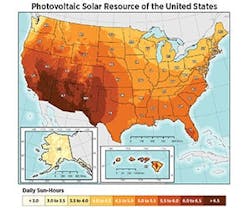Maximize Solar Return in Low-Sun Zones
Between incentives and dropping material costs, it’s more affordable than ever to harness solar power for your facility. But is it worth the money if your building isn’t in a high-sun region like California?
The answer is yes – if you can derive a positive result from the other issues that affect financial viability. Justify the solar project in terms of installed cost, cost of capital, solar resource, and incentives, recommends John Whisman, principal of the international solar energy consulting firm Verisol, Inc.
Costs of Installation and Capital
Thanks to steady declines in the cost of materials and manufacturing, prices for PV panels continue to drop, adds Clay Sterling, regional training officer for the Midwest Renewable Energy Association, which manages the Midwest Solar Training Network. The lower cost can help justify solar harvesting outside the sunniest regions of the U.S.
“We have less sunlight in the Midwest, so it takes more solar modules to do the same amount of work, but we can make a greater contribution,” Sterling says. “The dollars per watt to install are half of what they were last year. Installations are generally around $4 per watt. In 2010, it would have been double that.”
The cost of capital for solar PV, like many other industries, is relatively high because the supply of investment capital is low relative to the demand, Whisman explains. Unfortunately, there’s not much FMs can do to influence the cost of capital, so it’s best to focus on finding an affordable installer and making the best use of available sun and financial incentives.
Solar Resource
The Southwest has the best solar resource by far, averaging up to eight sun-hours (kWh per square meter) per day, Sterling says. The Upper Midwest, however, only receives four to five sun-hours per day – even less in the Cascades. But this doesn’t mean shadier regions can’t reap gains from solar power.
“Germany is further north than we are and has more cloudy days than Wisconsin,” Sterling explains. “But their contributions to renewable energy with both solar and wind are far greater than anywhere else in the world because they bought into the idea that it’s a good thing. The Upper Midwest could use them as a benchmark.”
To reap the maximum financial reward from your panels, consider the impact of seasonal variations and the regional climate on your system’s ability to harvest solar energy. Proper maintenance is vital for efficient performance, so understanding the conditions that panels experience will show you how to derive the best benefit year-round.
“Remember to keep the panels clean. They generate more power when they’re clean than when they’re dusty,” Whisman explains. “In areas where it rains year-round, there will be very little need for cleaning. But in areas like California and the Southwest, you might need to clean once or twice during the summer.”
Installation also affects efficiency, especially in snowy environments where panels must be installed at an angle that maximizes solar harvesting while minimizing snow accumulation. If snow does stick, clear off the buildup with a broom or squeegee so the panels can harvest as much sun as possible, Whisman says.
In addition, Sterling says, the cold temperatures might boost the efficiency enough to make up for the shorter solar window in winter.
“Heat is resistant, so in the summertime, a solar module is less efficient because the temperature is higher,” Sterling explains. “In the winter, the cell will run cooler and could put out beyond its specs. In the winter, the Midwest has really useful sun from about 9 a.m. to 3 p.m., but the power off the panels is greater because of the cold and the reflection from snow.”
Incentives
Rebates from the federal government (such as the 30% tax credit for any business that owns a solar power system) and your state may defray some of the installation cost, either by reimbursing a portion of the initial spend or by issuing a rebate calculated by the capacity of your system. A database of such incentives is available at dsireusa.org.
Your local utility may also offer assistance, either by issuing a similar rebate or by buying back the energy you generated, Sterling says. However, state and local regulations also play a role – there may be a limit to the number of credits or the size of the rebate you can earn.
“All utilities are required by federal law to allow you to hook up your renewable system and store energy, with the utility getting a credit at retail rates. But the catch is that each state and some utilities have a different way of accounting for that,” Sterling explains.
“Here in Wisconsin, we can put out 20 kW, sell it back at retail, and get a credit. Once we go above that 20 kW cap, we’re going to buy electricity at 12 cents and get credits at wholesale rates, which are around 3.2 cents,” Sterling continues. “For many businesses 20 kW is going to be fine, but for a department store or larger commercial applications it’s just a drop in the bucket. Other states, like Minnesota and Iowa, have 500 kW limits.”
Make sure you also check with your solar vendor or manufacturer. They may offer advantageous payment plans that allow you to realize an earlier payback period.
“Most systems in the US, depending on the incentive level, pay back in four to seven years,” Whisman notes. “They can normally be financed with no money down and be cash flow positive from day one.”
